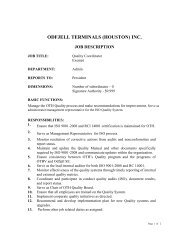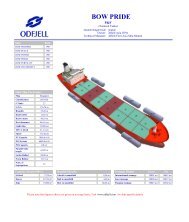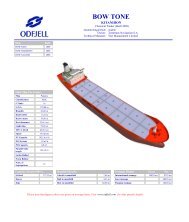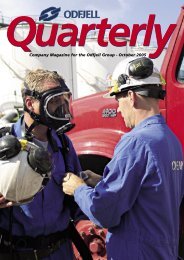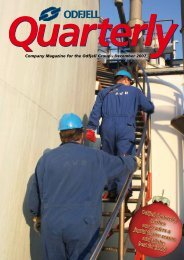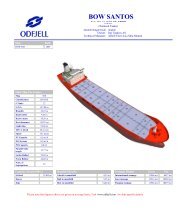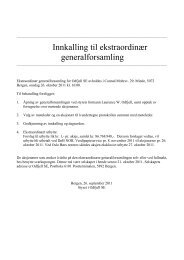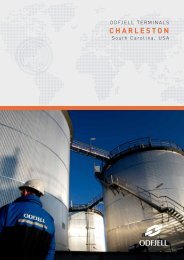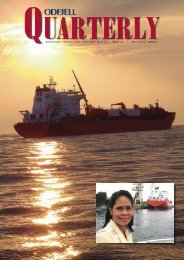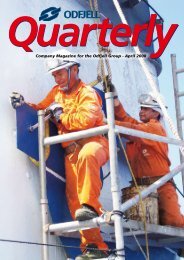Odfjell SE Annual Report 2012
Odfjell SE Annual Report 2012
Odfjell SE Annual Report 2012
Create successful ePaper yourself
Turn your PDF publications into a flip-book with our unique Google optimized e-Paper software.
ships are used for the most specialised types of chemical<br />
products, which in addition to requiring stainless steel<br />
transport, may also demand special handling in terms of<br />
temperature and pressure control. Stainless steel cargo<br />
tanks are also required for carriage of different types of<br />
acids.<br />
the core chemical tanker fleet<br />
For a global and long-term operator such as <strong>Odfjell</strong> it is<br />
clearly an advantage to possess a varied and efficient mix<br />
of ships and thus, to be able to adapt rapidly to changing<br />
market requirements.<br />
<strong>Odfjell</strong> carries several hundred different products every<br />
year; organic chemicals such as alcohols, acrylates, aromatics<br />
as well as clean petroleum products, lubricating<br />
oils, vegetable oils, animal fats and inorganic chemicals<br />
such as sulphuric and phosphoric acids and caustic soda.<br />
With a frequent presence in all major trade lanes, <strong>Odfjell</strong><br />
can offer unique and flexible services allowing customers to<br />
ship small parcels from 100 to 150 tonnes to full cargoes of<br />
up to 50,000 tonnes. By entering into contracts of affreightment,<br />
the customer can plan regular shipments in order to<br />
meet required delivery targets. However, a significant part<br />
of the cargoes carried by chemical tankers is fixed in the<br />
spot market, often by trading companies taking advantage<br />
of arbitrage of commodity prices.<br />
<strong>Odfjell</strong>’s strategy involves consolidation of loading and<br />
discharging operations at certain key hubs for chemical<br />
distribution. Our investments in small ships for transhipment<br />
purposes, and in tank terminals at major ports such<br />
as Houston, Rotterdam, Singapore and Onsan, play an<br />
important role in this respect.<br />
15.9% <strong>Odfjell</strong><br />
13.1% Stolt-Nielsen<br />
7.9% Fairfield Iino<br />
6.5% Tokyo Marine<br />
5.5% Navig8 Chemicals<br />
5.4% MISC<br />
5.3% Nordic Tankers<br />
17.4% Other majors<br />
23.0% Others<br />
We define a core chemical tanker as follows:<br />
• IMO II capacity, fully or at least centre tanks<br />
• Average tank size ≤3,000 cbm<br />
• Commercially controlled by core chemical operator<br />
• Chemical carrier with ≥50% stainless steel capacity<br />
Tank terminals are an integral part of the chemical logistics<br />
chain and their services constitute a natural link between<br />
our traditional shipping services and inland transportation<br />
by different modes such as barges, railcars, trucks, ISO<br />
containers and pipelines. <strong>Odfjell</strong>’s tank terminals handle,<br />
store and distribute bulk liquid chemicals to and from all<br />
different modes of transportation.<br />
83<br />
odfjell annual report <strong>2012</strong>




